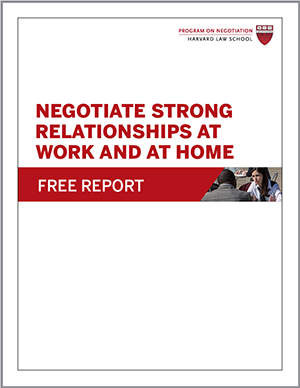
Here’s a great example on how to avoid litigation by pursuing negotiation with your counterparts. In the face of antitrust charges, Google’s guiding principle for dispute resolution is “Don’t litigate, negotiate,” according to the Wall Street Journal.
In the past, U.S. and European regulators have accused Google of abusing its dominance in online searches by promoting its own services, such as Google Shopping, at the expense of its competitors’ services. Rival comparison-sites such as Nextag complain that Google lists their products far below Google Shopping results, where they are less likely be found, in consumer searches.
Negotiation Case Studies: Google and the FTC
Back in 2014, Google avoided formal charges by the Federal Trade Commission by agreeing to make small changes to its search practices. That February, Google reached a similar deal with European Commission regulators, promising to reserve space high on its European search pages for competitors to offer their own search results, albeit only after paying Google for the space. The rivals’ offerings would be shaded and marked as “alternatives.”
The deal allowed Google to avoid an official probe and a potential fine of up to 10% of its global annual revenue, which was $59.8 billion in 2013, according to the Journal. Google competitors, including Microsoft and Nokia, said the settlement terms did not go far enough.
In stark contrast to Google’s strategy of negotiation as dispute resolution, Microsoft fought European antitrust charges for a decade, a battle that ultimately cost the company more than $2.5 billion in fines.
Over the course of the three-year European investigation, Google worked closely with regulators, at times flying its engineers to Brussels, Belgium, to describe the intricacies of its products. After two earlier tentative agreements fell apart in the face of criticism, Google offered “slightly sweetened deals,” the Journal reports. Both sides said they had been eager to avoid a court battle.
Given the high costs and risks of litigation, it usually pays for parties engaged in dispute resolution to try hard to reach a settlement before taking their dispute to court, according to Harvard Law School professor Robert H. Mnookin.
Here are five strategies from Mnookin to help you and your lawyers turn disputes into deals:
Dispute Resolution Strategy 1: Explore the possibility of engaging in a formal dispute-resolution process such as mediation before going to court.
Dispute Resolution Strategy 2: Identify and express your myriad interests in the dispute, including those that are not financial, and encourage the other side to do the same.
For example, if you feel wronged, you might ask for a formal apology or evidence that the other party is taking steps to correct its mistakes.
Dispute Resolution Strategy 3: Ask your lawyers to systematically predict the outcome of a possible court case through decision-analysis tools such as decision trees.
Such analyses often make it crystal clear that a negotiated settlement would be a far less risky and costly option for dispute resolution.
Dispute Resolution Strategy 4: Open up to your lawyer about all of your interests and concerns, including those that are personal and emotional.
Too often, clients allow their lawyers to focus exclusively on financial claims—and unwittingly narrow the possibilities for a negotiated settlement.
Dispute Resolution Strategy 5: Align your interests with your lawyer’s through the use of ultimatums and incentives.
For example, you might promise your lawyer a financial bonus if she settles the case in a timely manner.
Which dispute resolution strategies did you find helpful? Leave a comment.
Related Dispute Resolution Posts:
These Examples Illustrate the Importance of Negotiation in Business – Negotiation case studies illustrating the benefits of engaging in integrative bargaining with business counterparts.
Dealmaking: 5 Tips for Closing the Deal – Five negotiation tips for sealing the deal at the negotiation table.
How Case Studies Facilitate Negotiated Agreements – An examination of the impact of case studies on forging negotiated agreements.
Dealmaking: Before You Sign on the Dotted Line
New Book Series: Breakthrough International Negotiation
Originally published in 2014.






I have been a mediator for 12 yrs and conducted over 2100 mediations and mediated for over 7,000 hours. I absolutely agree with the 5 strategies. Many times, lawyers look past logic and reason and simply look to the finances. It’s a shame, but lawyers generally get paid the longer a dispute goes. Everything can be negotiated if the underlying reasons behind the dispute can be exposed and addressed. It is important that the client or the parties to the dispute maintain control of the negotiation using the “advice” of their counsel for what it is, “advice”.
Evidence is compelling..Litigation costs money…Negotiation saves billions…..You can’t afford not to adopt formal dispute resolution processes such as mediation.
Rather than calling it the “Google approach”, you might want to call it the “Non-American approach”. Because it feels more and more as if the American standard response to anything even remotely confrontational is litigation or even outright conflict. Words such as compromise and diplomacy seem to have been relegated to the “if nothing else works” position. A pity. For so much more can be achieved through negotiation, as Mr Mnookin so rightly points out, than through the “Shoot first, shoot hard” approach. And a large chunk of the rest of the world knows this, and gets things done smoothly and quietly through negotiating, bargaining, compromising, talking.
excellent!!!
Nice!! Where’ s number 5? Edit room cut? 🙂
The number 5 has rejoined the conversation Charley! 🙂 Thank you for your feedback!